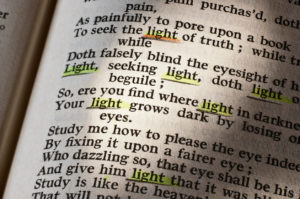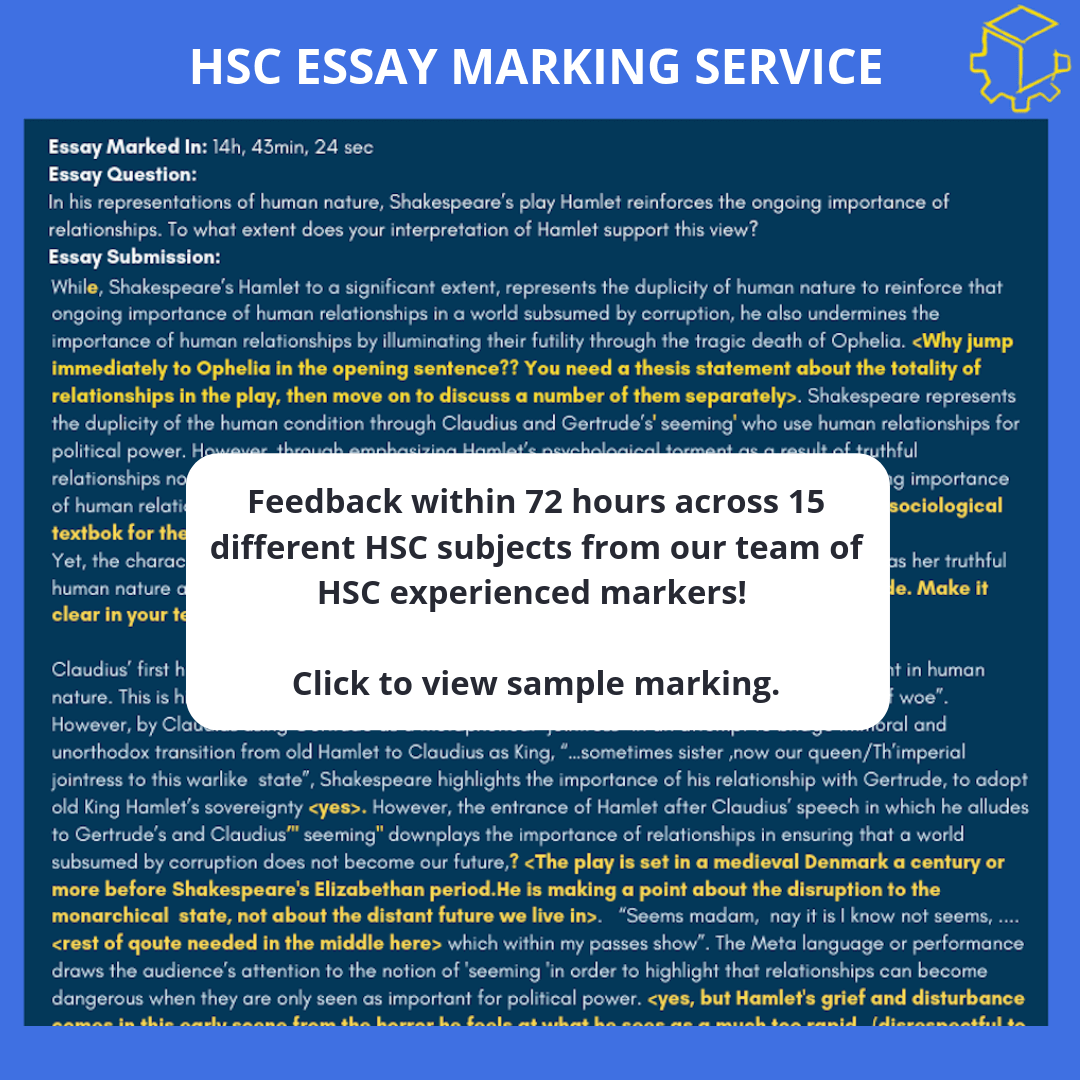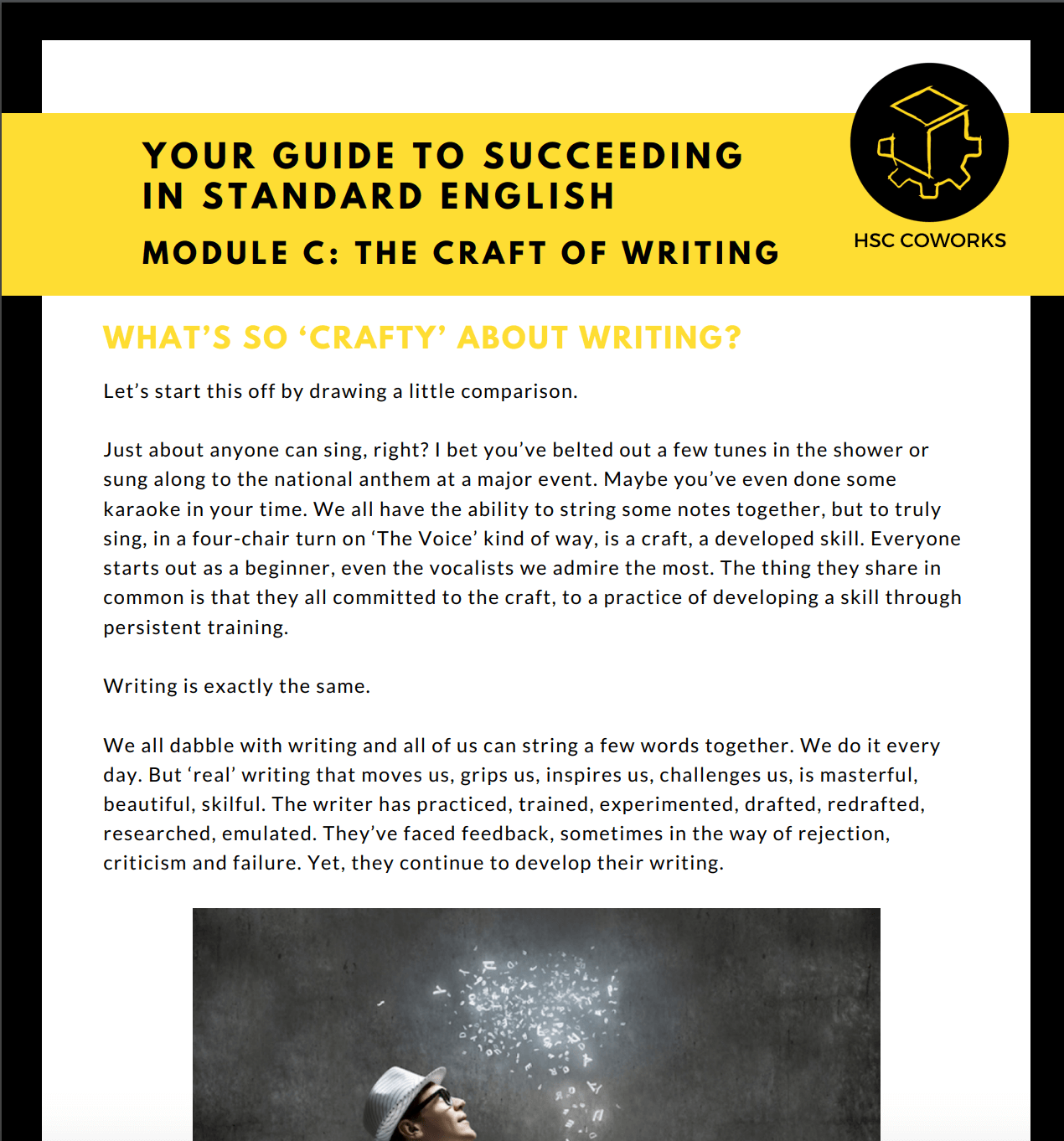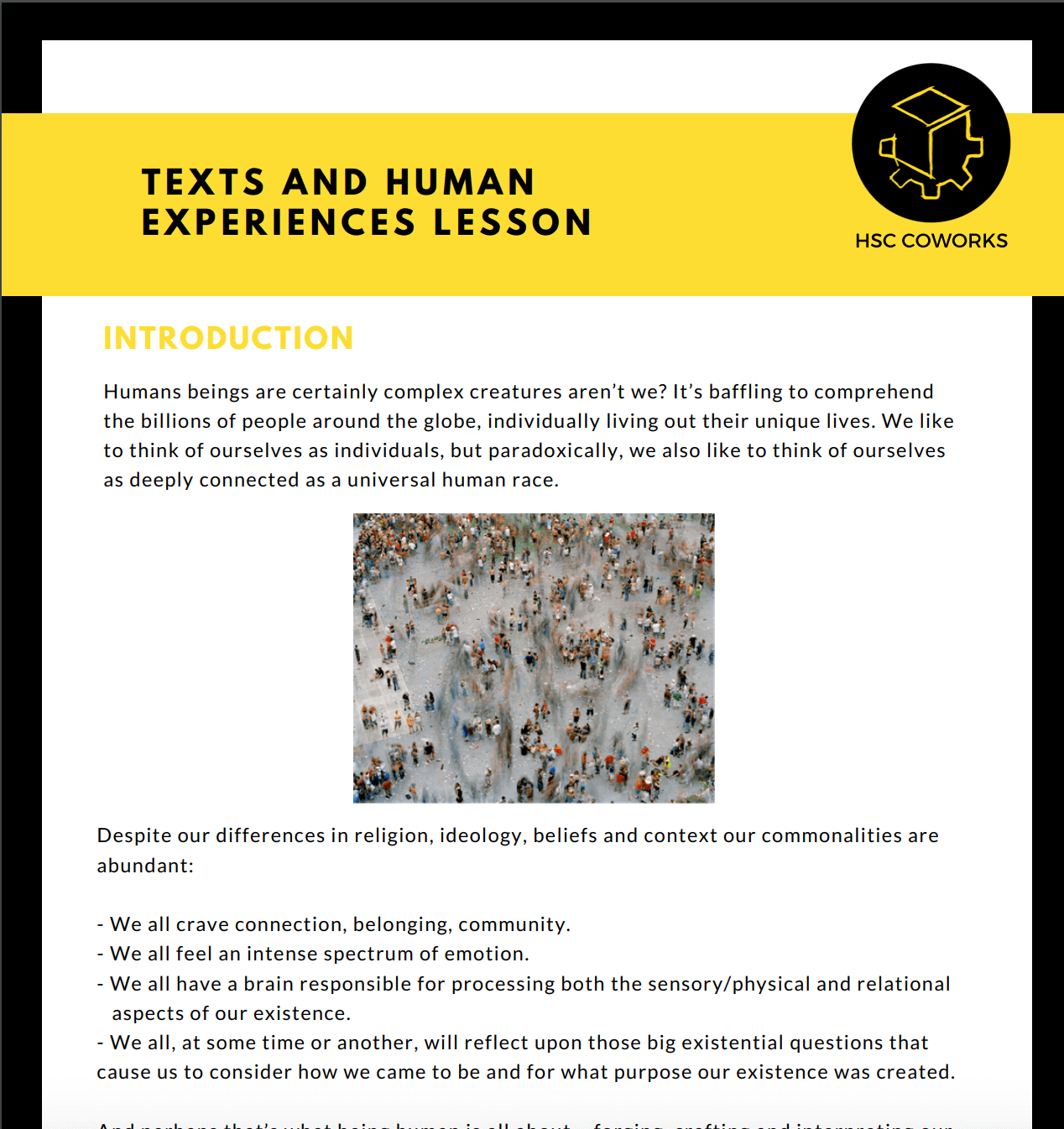HSC ENGLISH LANGUAGE TECHNIQUES
 Shakespeare demonstrating some light repetition
Shakespeare demonstrating some light repetitionAs long as writers have been writing, they have been inventing and employing literary devices. Great writers employ literary devices not just for artistic value, but to give readers a greater understanding of their works.
The deeper your understanding of literary devices, the more effectively you can captivate your reader. Complicating matters slightly is the fact that there are literally hundreds of literary devices in existence.
While you may not be able to learn them all, these are some of the most common and engaging devices that will take your writing to a more advanced level. You should work on your ability to recognise these devices in the work of others as well as your ability to integrate them into your own writing.
ADAGE
Generally based on fact, an adage is a short and memorable saying that is considered to be the absolute truth by the majority of people. Some examples include –
“The world’s a stage” – As You Like It, William Shakespeare.
“Slow and steady winds the race” – The Tortoise and the Hare, Aesop.
ALLEGORY
An allegory is a narrative with one obvious, literal meaning, and another ‘hidden’ meaning, intended to teach a moral lesson. These ‘lessons’ are often a commentary on real life events, or an issue specifically related to the theme of the story.
A classic example is George Orwell’s Animal Farm, where one of the rules of the farm is – “All animals are created equal, but some animals are more equal than others.” This story is an allegory of the Communist Revolution in Russia, right before WWI, and the animals represent sections of Russian society post-revolution.
Alliteration
Derived from “latira”, a Latin word meaning “letters of the alphabet”, alliteration is a stylistic device where a number of words with the same consonant sound are placed close together. Alliteration is dependent on the sounds, rather than the letters, so nine knocks is alliterate, but charred cords is not.
There are obvious examples, like –
“Peter Piper picked a peck of pickled peppers.”
or much less pointed, literary examples, such as the following passage from James Joyce’s “The Dead”, where alliteration is used on s’s and f’s –
“His soul swooned slowly as he heard the snow falling faintly through the universe and faintly falling, like the descent of their last end, upon all the living and the dead.”
ALLUSION
An allusion refers to a quick, indirect reference to an event, moral or character from another time, place or story. Time is not spent explaining the reference, but rather it is merely a passing comment, where the author relies on the reader’s assumed knowledge to understand the meaning.
The Harry Potter series is packed full of allusions, some obvious, and some disguised… and J.K. Rowling LOVES referring to mythology. For example, the character Remus Lupin is a werewolf, and his name alludes to this. Remus refers to Romulus and Remus, brothers from Greek Mythology, who were raised by wolves. Lupin also isn’t without meaning – in Latin, “lupus” means “wolf”.
👋🏼 Happy new year & WELCOME BACK to HSC CoWorks! 👋🏼
Our Year 12 program has now started for 2026! Come to your weekly coaching sessions, drop into Ask a Coach for support & book 1-on-1 time with our expert Teachers 🤩
Our Year 11 program will begin for those who have placed a deposit during the week of February 9.
Our Year 9 & 10 program will begin on Sunday February 15th.
Lets go 2026! 💫 #hsccoworks

Make the most of your Summer Holidays and join our January Holiday Study Bootcamp 💪🏻🥾
Collaborate with our expert team of coaches to consolidate everything learned in Term 4, and prepare for the huge year ahead! 😱
Once Term 1 begins, you’ll jump straight into learning new content & completing new assessments. So let’s take advantage of the golden opportunity that the Summer Holidays presents! ☀️
Link in bio 🔗 #hsccoworks #studybootcamp #year12

Bring on the Summer Holidays! ☀️ Just a reminder that HSC CoWorks is closed from December 12th - January 11th 🎄
During this time, there will be no weekly coaching sessions, Zoom-an-Expert or Ask a Coach 🚫
However students will still have full access to the CoWorks Portal!
✅ Stay on track ✅ Revise Term 4 ✅ Prepare for Term 1!
We look forward to working with you in 2026 from January 12th! 🤩
#summerholidays #hsccoworks #holidayclosure

Congratulations to our 55 students who achieved the Start Strong HSC challenge 👏🏼👏🏼👏🏼
Our 5 lucky winners of a $150 Westfield Voucher are:
⭐️Laila (Bondi Junction)
⭐️Nate (Balgowlah)
⭐️Oliver C (Mosman)
⭐️Byron (Balgowlah)
⭐️Eva (Chatswood)
All 55 students also receive a Açai Bowl from our friends at @blessed.bowls and a CoWorks Trucker Cap.
More challenges and prizes to come in 2026 to help get students to the top of Mount HSC with no regrets.
#hsc2026 #hsc2027

OUR SUMMER HOLIDAYS STUDY GUIDE IS HERE ☀️ Make the most of your Summer break to consolidate what you have learnt in Term 4, and to prepare for the big year ahead! Take advantage of this golden opportunity ✨
Comment YES & we will DM you your Summer Holiday Study Guide! 📥
#studyguide #hsc2026 #summerholidays

Alter-ego
A character that is used by the author to speak the author’s own thoughts; when an author speaks directly to the audience through a character.
On many occasions, an alter-ego is used to allow the character to explore feelings and situations they normally wouldn’t. Take Youth in Revolt, the main character is shy and withdrawn and uses his alter ego to fulfil his outrageous and rebellious needs.
Analogy
When two unlikely things are compared to one another, this is called an analogy. The things are often quite different from one another, and their comparison aims to explain the idea by likening it to something more familiar to readers.
Probably the most famous example comes from Shakespeare’s Romeo and Juliet –
“What’s in a name? That which we call a rose
By any other word would smell as sweet.
So Romeo would, were he not Romeo called.
EXPERT TIPS: CLICK ON IMAGE
Caricature
Much like the well-known caricature drawings, the caricature literary device plays on exaggerating particular aspects of a subject for comic effect. This is often used to give a humorous edge to a narrative, or in political satire pieces.
A great example is a piece by the great Charles Dickens –
“Mr. Chadband is a large yellow man, with a fat smile, and a general appearance of having a good deal of train oil in his system. Mrs. Chadband is a stern, severe-looking, silent woman. Mr. Chadband moves softly and cumbrously, not unlike a bear who has been taught to walk upright. He is very much embarrassed about the arms, as if they were inconvenient to him.”
Cliché
“Happily ever after” is probably the most obvious and overused cliche in the English language. It refers to a saying that has been used to an extent of exhaustion, so it loses its original meaning and loyalty. Unless they are used ironically, it is generally considered unimaginative to use them.
Some examples include, “he ran like the wind”, “a matter of time” and “frightened to death”.
Climax
The climax refers to the pinnacle of a stories arch, when the conflict, tension or excitement reaches the highest point. It is generally the turning point of a narrative, when the rising action becomes falling action, after a narrative resolution has been found. It is an essential plot device.
A great example is when the clock strikes twelve in Cinderella, and she must make it home before her carriage becomes a pumpkin, her dress becomes rags and her secrets are discovered.
Conflict
Conflict is a literary element, where two opposing forces struggle against one another in the fight for their own desired outcome. The conflict can be between a protagonist and antagonist, or the protagonist can face resistance from a much broader force.
For example, in the movie Castaway, the main characters conflict is that he is stranded on a deserted island and must find a way to survive. The conflict is between him, and the fight to survive.
EXPERT TIPS: CLICK ON IMAGE
Dramatic Irony
Dramatic Irony works to increase suspense or comedic effect by letting the audience know something important, while the characters are kept in the dark.
Imagine a scene where the character walks into a house and only the audience knows the killer is in the house. Or in comedy when a character is imitating or ridiculing a protagonist while they are unknowingly standing behind them.
One clear example is Hamlet’s decision to test the guilty conscience of King Claudius by orchestrating the ‘play with the play’.
Epiphany
Originating from the Greek word epipaneia, an epiphany describes the moment when a character suddenly achieves realisation or awareness that brings clarity to a particular situation.
Isaac Newton had one of the most famous epiphanies of our time, when an apple fell from a tree onto his head, causing him to develop his Universal Law of Gravity.
Euphemism
An idiomatic expression used to veil a perhaps unpleasant or impolite meaning behind a phrase. It is a less offensive way of saying something that could be deemed harsh. A euphemism can also be used to exaggerate correctness and add a touch of humour.
For example, the term “vertically challenged” can be used in place of “short”, or you can tell someone that they’re “thinning a little on top” when they are going bald.
* access experienced hsc markers | hsc teachers | 72hr essay marking *
Flashback
Used to create a background to the present situation, place or person. Effective at giving the reader any extra information to understand an event or character motivation better. It is important to use flashbacks carefully or they can easily become cliché.
Harry Potter is another perfect example. The many flashbacks to Harry’s parents and traumatic events help build empathy in the reader and increase emotional investment in the plot.
Foreshadowing
Foreshadowing is used to give readers a hint of the events that will unfold later in the story. Chekhov’s Gun is perhaps the most famous example of this technique. It says, “if in the first act you have hung a pistol on the wall, then in the following one it should be fired”.
Shakespeare used foreshadowing to warn of Romeo and Juliet’s fate in Act II –
“Life were better ended by their hate, than death prorogued, wanting of thy love.”
Hyperbole
A hyperbole is a figure of speech, which uses specific words or phrases to exaggerate a statement for dramatic effect and emphasis. We also use hyperboles frequently in our day to day language.
Some examples include “I haven’t seen you in ages”, “Something weighs a tonne” and “I am dying of shame”.
years in business
essays marked in 12 mths
challenge questions attempted in 12 mths
longest streak (days)
Hypophora
A hypophora, also known as an antipophora or an anthypophora, is a rhetorical device where the writer poses a question, and then immediately answers it.
One example comes from Henderson the Rain King, by Saul Bellow –
“What made me take this trip to Africa? There is no quick explanation. Things got worse and worse and pretty soon they were too complicated”.
Imagery
Imagery uses rich, figurative language to describe characters, settings and scenes to build a mental image for the reader, appealing to their senses. It could be said that imagery is the writer’s way of painting a picture in the readers’ minds.
J.R.R Tolkien is a master of imagery, as shown in the following passage from the Lord of the Rings –
“It was in appearance a tall spacious tree of graceful form, with thin unwrinkled bark over white wood.”
Imagery doesn’t always appeal only to our ability to visualise. Imagery can also appeal to other senses, e.g. sound (auditory imagery), smell (olfactory imagery), taste (gustatory imagery) and touch (tactile imagery).
Win Prizes & Conquer your HSC…
with the HSC CoWorks Virtual Campus!
Inference
Inferences are used not only throughout literature, but also in everyday life. An inference is when you draw a conclusion based on logical deductions and facts.
For example, if your best friend were to walk out of an exam looking dejected, you would assume that the exam was not a success for them – this is an inference.
Irony
There are actually two types of irony, rather different from one another. Verbal Irony is a figure of speech, where words are used in a way that implies their meaning is vastly different from the actual, literal meaning. Situational Irony describes a scenario that ends in a way different than what would be anticipated.
For example, Verbal Irony would describe a moment when you exclaim “Oh, great!” after dropping your ice cream, whereas Situational Irony would be, as described by the great Alanis Morrissett, rain on your wedding day, or a free ride when you’ve already paid…
juxtaposition
Juxtaposition occurs when a number of characters, ideas or places are presented side by side, to highlight and develop contrasts and comparisons. This is often used by writers to achieve greater detail in a narrative, by highlighting particular aspects of something, by placing it with the opposing ideal.
The opening lines of Charles Dickens’ A Tale of Two Cities provide the perfect example –
“It was the best of times, it was the worst of times, it was the age of wisdom, it was the age of foolishness, it was the epoch of belief, it was the epoch of incredulity…”



litotes
Another word with Greek origins, this one is derived from the Greek word for “simple”. Litotes employ two double negatives to create a positive ideal, but leaving it entirely understated.
For example, replying “not bad” when you’re good is the most common example of this. Another example if saying “I am not as young as I used to be” in order to communicate that you are old without explicitly stating it.
metaphor
A metaphor is a figurative comparison between two entirely unrelated things, used in order to draw attention to a similarity between them. The resemblance between the two differing things is made possible based on a single similarity. Basically, it is when a writer portrays a place, thing, person or action are being something, even though it isn’t actually.
For example, if you describe your brother as the “black sheep” of the family, this is entirely metaphorical as your brother is neither black, nor a sheep (we assume). It instead describes the similarities between your brother and a black sheep.
moral
This device is derived from the Latin word ‘morālis”, and describes a lesson learned or message conveyed through a story, poem or event, that may either be expressed explicitly or simply inferred. They originate from the late 1700s and early 1800s, when literature was seen as something that need to serve a purpose, particularly to children.
A great example of this is the classic boy who cried wolf – if you cry wolf falsely, then nobody will believe you when you are actually telling the truth and in need of help.
motif
A motif is a repetitive element that occurs rather obviously throughout a story, such as a reference, concept or symbolism. They are used to present and reinforce an overall theme within a narrative, and help readers identify and understand an underlying message.
For example, the recurring motif throughout To Kill a Mockingbird is the suggestion that you cannot truly understand the plight of another person unless you try and see things from their perspective.
non sequitur
Derived from a Latin phrase meaning “it doesn’t follow”, non-sequiturs are statements that ignore the fundamental principles of reason, to form outlandish conclusions that make no logical sense. They are often used to inject humour into a piece.
An example would be – Sarah is a good surfer. Sarah is Australian. Therefore, all Australians must be good surfer.
nostalgia
The term nostalgia originates from a Homeric word, nostos, which means homecoming. It refers to a feeling that is often a mix of pleasure and sadness in the remembering of past events and longing to experience them again.
An example of nostalgia would be – Oh how I miss the summer holidays. The days spent in the sun at the beach.
onomatopoeia
Onomatopoeia is a form of auditory imagery that somewhat recreates the sound of the thing that it describes, allowing readers to ‘hear’ the action, immersing them further within a narrative.
For example, a writer could describe “a gushing river flowing through the valley”, which paints a much clearer image of the action, as opposed to “a river flowing through a valley” – you can ‘hear’ the sound of a river gushing.
oxymoron
An oxymoron draws together two opposing ideas to create a dramatic effect. The union of the two contradictory terms is used to provoke the reader, leaving them pondering on the meaning of the phrase, creating a paradox.
Shakespeare’s famous oxymoron, “sweet sorrow” is a great example of this, along with the terms “a deafening silence”, an “honest thief” and a “mini jumbo jet”.
paradox
A Paradox describes a seemingly illogical or contradictory statement that may include something that is sound to be true, upon further investigation. It can also be used to highlight something that is contrary to traditional beliefs, generally used to lure the readers into thinking of something in a new light.
Shakespeare provides the best example of this in Hamlet – “I must be cruel to be kind”.
personification
Personification is a device used to give human-like characteristics or attributes are given to inanimate objects, phenomena or animals.
For example, when we say that the “sky weeps”, we are giving the sky the human ability to cry, or when the “sun hides its face behind the clouds”, the sun is given human characteristics.
red herring
A Red Herring is a something introduced into a narrative under the guise of relevance, but is actually a fallacy used to detract the reader from the actual issue. It is often used throughout crime stories to mislead both characters and readers into drawing false conclusions.
In Sir Arthur Conan Doyle’s Sherlock Holmes: Hound of the Baskervilles, readers are introduced to an escaped convict early in the story, so that they will assume he is guilty given his past, detracting attention from the real killer.
repetition
Repetition refers to act of using the same word, or words over and over again, to reinforce its importance or build suspense. While stylistically appealing, especially within poetry and theatre, this device also stresses the significance of a specific message.
S.T. Coleridge employs this device is his poem, Rime of the Ancient Mariner –
I looked upon the rotting sea,
And drew my eyes away;
I looked upon the rotting deck,
And there the dead man lay.
satire
Satire employs the use of humour, irony and exaggeration to ridicule or ironically commentate on a serious subject or group. It often sorts to initially expose, and then criticise acts of foolishness and corruption through the use of a fictional situation that mirrors real life events. In modern times, most examples of satire are pointed toward political figures. Popular TV shows such as The Daily Show and The Colbert Report rely on satire as the cornerstone of their content.

Receive feedback and a mark on your essays!
setting
Setting refers to the time and place in which a narrative takes place. The setting can be as particular as a tiny cottage in the countryside, or as broad a region or time period. Different aspects of setting can also include weather conditions, social conditions and environment, historical time period, geographical location and timing. Setting is often vital to a narrative.
For example, Emily Bronte’s Wuthering Heights relies heavily upon its setting, as the surroundings directly reflect the mood of the characters and their actions, lending to the overall atmosphere of the narrative.
simile
A simile is a figure of speech that draws vivid and often dramatic comparison between two very different things. It differs from a metaphor in that is draws resemblance between the two things using words such as “like”, “as” or “than”.
In Vladimir Nabokov’s Lolita, he employs the following simile –
“Elderly American ladies leaning on their canes listed toward me like towers of Pisa.”
solecism
Another word derived from Greek, Solecism originates from the word soloikismos, meaning to speak incorrectly. It is a stylistic device which deviates from conventional grammar, syntax or pronunciation for dramatic effect. It is often used to add authenticity to a setting or character.
For example, Hagrid, from the Harry Potter series, has solecism employed in his dialogue –
“I’m a what?” gasped Harry.
“A wizard, o’ course,” said Hagrid, sitting back down on the sofa, which groaned and sank even lower, “an’ a thumpin’ good’un I’d say, once yeh’ve been trained up a bit. With a mum an’ dad like yours, what else would yeh be?”
soliloquy
A soliloquy is used to reveal a character’s innermost thoughts to the reader, often portrayed as the character talking to themselves without the presence of another person. It is often used to create a revelation or manifestation to the reader.
The most famous soliloquy, without question is from Shakespeare’s Hamlet –
“To be, or not to be – that is the question.”
symbolism
Symbolism refers to a character, object or action that is concealing a different meaning that is generally much deeper and more significant to the narrative.
Examples of every day symbolism include the use of red roses, or the colour red in general, to symbolise love, and the dove as a symbol of peace.
tone
Tone often refers to the attitude that a writer has towards a particular subject or audience, made obvious through the delivery, figurative language and organisation. Tone can vary from formal to informal, playful to serious or sad to cheerful. While every narrative contains a central theme, the way in which the writer approaches this theme provides the overall tone of the piece.
For example, in Robert Frost’s poem The Road Not Taken, the last stanza begins with “I shall be telling this with a sigh”, setting the tone as unhappy, or perhaps leading the reader to thinking that the speaker had to make a difficult choice.










